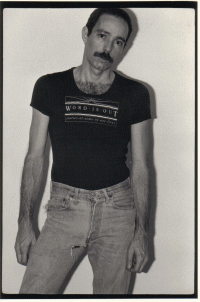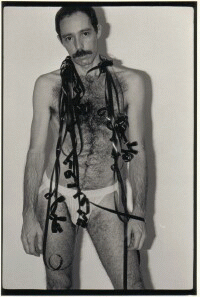 Gays In/At The Movies:
Gays In/At The Movies:
An Appreciation of Vito Russo
By Arnie Kantrowitz
I dreamed about him again last night. It’s been more than sixteen years since he died, but still he is a part of my every day. Vito Russo was the most life-loving person I ever knew, and it’s not like him to let a little thing like death stand in his way.
In this dream, he had just opened a fabulous new restaurant, and people of every sort were there while he hospitably nodded and conversed — a glass in one hand, a cigarette in the other — gliding through the crowd in a black and white caftan I remember from our summers on Fire Island. Vito loved to entertain as many guests as he could crowd into his small apartment. He mixed doctors and film critics, academics and street drag queens, Lesbian activists and society matrons, and everyone had a good time.
Whenever I ride down Manhattan’s Ninth Avenue, as I pass Twenty-Fourth Street, I look at the building on the northwest corner and remember entering it to the smell of the superintendent’s cat box and climbing up the well-worn stairs to knock on Vito’s door. There was a sort of magic inside, but it was certainly no Disneyland; it was a working-class place, which Vito had dolled up by redecorating along with each new man in a successive line of boyfriends, but whatever changes he made — repainting, refurnishing, even tearing down walls — a picture of his beloved Judy Garland remained in every room.
His kitchen — he loved to cook — was spare, but boasted a collection of French copper pots and a few discreetly placed mousetraps. His bedroom, which had room for little beside its large platform bed, opened onto his narrow office space, where he worked on his many essays and film reviews, along with his masterpiece on Gays in film, The Celluloid Closet. (His original title was "Gays In/At the Movies" until a calmer head prevailed.) His living room was dominated by a movie screen, permanently affixed to a wall. He owned a small collection of feature films and Judy Garland TV specials transferred to film, and a reel of Bette Midler at the Continental Baths. But he borrowed and traded films and always had something new to project when company came, which was most of the time.
 He employed his sparkling charisma to excite anticipation in his visitors about whatever he was going to show because he loved to watch people watching movies. His favorite film was Caged, featuring Eleanor Parker as a naïve young newcomer to a women’s prison who catches the eye of Lesbian Lee Patrick and grows into a hard-bitten ex-con. He loved its opening words: “Pile out, you tramps. It’s the end of the line.” And he loved the comeuppance of Hope Emerson, the sadistic matron who ends up with a fork stuck in her breast. He had a predilection for films featuring noble women or African-Americans, Gay themes, or camp, which I think he took quite seriously, but he was at home with all movies, doting on a message, a performance, a plot twist or a significant moment. Those moments — sharp dialogue, covert glances, bits of action — collected since he was a boy, had laid the foundation for his encyclopedic knowledge of film.
He employed his sparkling charisma to excite anticipation in his visitors about whatever he was going to show because he loved to watch people watching movies. His favorite film was Caged, featuring Eleanor Parker as a naïve young newcomer to a women’s prison who catches the eye of Lesbian Lee Patrick and grows into a hard-bitten ex-con. He loved its opening words: “Pile out, you tramps. It’s the end of the line.” And he loved the comeuppance of Hope Emerson, the sadistic matron who ends up with a fork stuck in her breast. He had a predilection for films featuring noble women or African-Americans, Gay themes, or camp, which I think he took quite seriously, but he was at home with all movies, doting on a message, a performance, a plot twist or a significant moment. Those moments — sharp dialogue, covert glances, bits of action — collected since he was a boy, had laid the foundation for his encyclopedic knowledge of film.
His mother, Annie, told me he was always running off to the movies as a kid in New York City. She and I found it easy to talk to each other. She had a limited education and a brash New York accent, but she knew the truth when she saw it and wasn’t afraid to say so. She told me that when the family moved to suburban Lodi, New Jersey, Vito said that when he was 21, he was moving back to New York, the capital of glamour, where he belonged. Sure enough, on the morning of his 21st birthday, he came downstairs with his suitcase packed and left for the hardscrabble land of his dreams. The glamour would come, but not until he worked his way to it.
Not long after he arrived in New York and secured a job as a waiter at the Omnibus restaurant in Greenwich Village, the Gay liberation movement exploded in the wake of the Stonewall riots. Just before the end of 1969, a small group of twelve activists split off from the Marxist-oriented Gay Liberation Front to form the more reform-minded, militant, but non-violent Gay Activists Alliance, and soon I was swept up in the movement. A few weeks later, a new friend told me, “There’s a guy you absolutely have to meet,” and we went to the Omnibus for dinner. Vito joined the new group immediately, and in short order, he and I and the organization’s president, Jim Owles, were friends for life. As far as Annie was concerned, his friends were her friends, and his cause was her cause. We were always welcome at her home. When we weren’t at GAA meetings or demonstrations or Sunday brunch, we were running over to each other’s apartments or talking endlessly on the phone. Vito told me, “You can say anything to me, and I won’t go away.” The agreement worked both ways.
The Gay Zeitgeist of the early 1970s was focused on visibility. It created a binary division of straight and Gay for political purposes. Of course, some of us knew from our own experience that sexuality is malleable, but we had chosen the model of a pluralistic political minority, containing middle class white boys, black drag queens, Asians and Latins from Manhattan and the outer boroughs, macho leathermen and Lesbians bent on self-determination. We were seeking equal rights as a voting bloc, and in the name of identity politics, as it came to be known, everyone was either Gay or straight and either in or out of the closet. Bisexuals (though many were among us) were considered semi-closeted Gays, and sleeping with the opposite sex was looked on as a form of treason. When academics began to question the validity of that world-view and spin post-modern theories about the meaning of desire and what that meaning means, Vito had little patience for such ivory tower pursuits, even though he had a Master of Arts degree in film from New York University.
Vito’s roots as a Gay activist informed his criticism of film. For him the questions were about fairness and accuracy, more political than aesthetic issues. Here is an excerpt from a speech he gave at Yale University in 1987:
This is just an excerpt from this issue of White Crane. We are a reader-supported journal and need you to subscribe to keep this conversation going. So to read more from this wonderful issue SUBSCRIBE to White Crane. Thanks!
Arnie Kantrowitz is professor emeritus of English at the College of Staten Island, CUNY. He is the author of Under the Rainbow: Growing up Gay, an autobiography; Walt Whitman, a Gay biography; and many anthologized essays. He lives in New York with his partner Lawrence Mass.